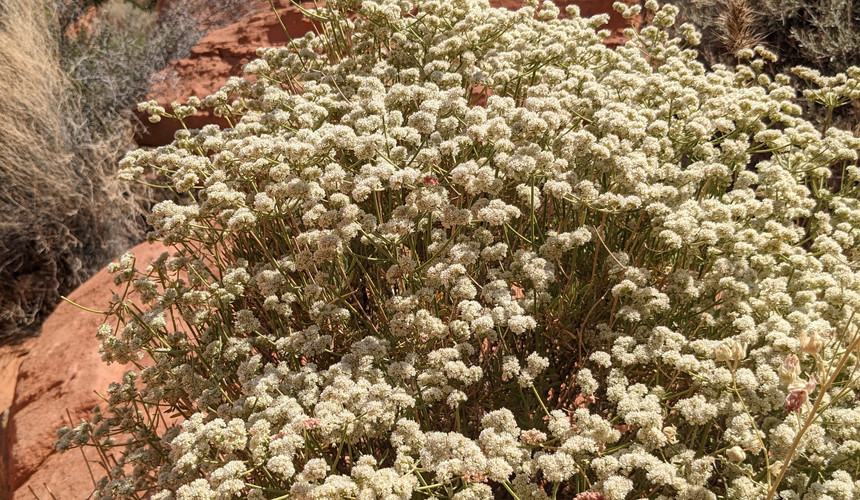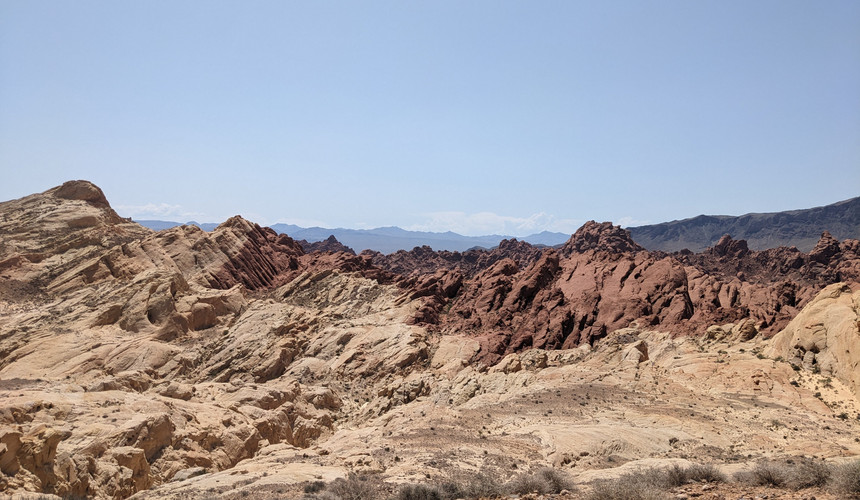
As gardeners, learning about plants is almost as much fun as planting them! Our members often travel to exotic places, take photos of the plants and send them to us to be featured. Recently, a member went to Nevada and spent some time in the hot desert sun at Fire Canyon.
One interesting fact before entering the canyon was the cryptobiotic soils found in the rock formations. Cryptobiotic soils, also known as biological crusts, are unique soil surface formations found in arid and semiarid environments. They are composed of a complex symbiotic community of organisms, including cyanobacteria, lichens, mosses, fungi, and algae. These organisms work together to form a living crust that covers the soil surface, providing various ecological benefits.
Some key components and characteristics of cryptobiotic soils:

Cyanobacteria: Cyanobacteria, also known as blue-green algae, are the primary organisms responsible for forming cryptobiotic soils. They have the ability to photosynthesize and fix atmospheric nitrogen. These bacteria are critical in binding the soil particles together, preventing erosion, and enhancing soil stability.
Lichens, Mosses, and Algae: Alongside cyanobacteria, other organisms like lichens, mosses, and algae also contribute to the formation of cryptobiotic soils. Lichens are symbiotic associations between fungi and algae or cyanobacteria. These organisms provide additional structural stability to the soil crust.
Physical Structure: Cryptobiotic soils have a unique physical structure with a crusted or lumpy appearance. The crust forms a protective layer on the soil surface, shielding it from erosive forces such as wind and water. This structure helps to reduce soil erosion and maintain soil moisture by trapping water.
Water Absorption and Retention: Cryptobiotic soils have the ability to absorb and retain water more effectively than bare soil. The crust's surface features, including its lumpy structure and excreted extracellular substances, enhance water infiltration and reduce water loss through evaporation. This water retention capacity is vital for supporting plant growth and promoting ecosystem resilience in arid environments.
Nutrient Cycling: The organisms within the cryptobiotic crust play a significant role in nutrient cycling. Cyanobacteria fix atmospheric nitrogen, providing a source of nitrogen for the surrounding ecosystem. These organisms also trap dust particles and organic matter, contributing to nutrient availability in the soil.
Biotic Interactions: Cryptobiotic soils support a diverse range of microorganisms and invertebrates. These organisms interact with the soil crust, contributing to nutrient cycling, decomposition of organic matter, and the overall ecological functioning of the ecosystem.
Cryptobiotic soils are ecologically important components of arid and semiarid ecosystems. They play a crucial role in soil stabilization, water infiltration, nutrient cycling, and biodiversity maintenance. It is essential to protect and preserve these delicate soil formations to maintain the ecological integrity of desert environments.
Mountain goats in the desert
En route, our members also came across some cute mountain goats eating the leaves of the shrubberies! It had rained and even flooded in some areas a few weeks before their visit, so the vegetation was greener than normal.
Plants that thrive in the desert
The Nevada desert is a harsh and arid environment with extreme temperatures and limited water availability. Despite these challenges, several plant species have adapted to survive in this desert region. Here are some common plants found in the Nevada desert:

Joshua Tree (Yucca brevifolia): The Joshua Tree is an iconic plant of the Mojave Desert, which extends into parts of Nevada. It has a unique and distinct shape with tall, branching arms that reach towards the sky.
Desert Sage (Salvia dorrii): Desert Sage is a low-growing shrub with silver-gray leaves and vibrant purple flowers. It is well adapted to the arid conditions of the Nevada desert.
Creosote Bush (Larrea tridentata): Creosote Bush is a common plant found in the desert regions of Nevada. It has small, dark green leaves and produces yellow flowers. The leaves release a distinct aroma after rainfall.
Prickly Pear Cactus (Opuntia spp.): Prickly Pear Cactus is a type of cactus that thrives in the desert environments, including parts of Nevada. It has flat, paddle-shaped stems covered in spines and produces colorful flowers.
Mojave Yucca (Yucca schidigera): The Mojave Yucca is a yucca species native to the Mojave Desert and can be found in Nevada. It has long, sword-shaped leaves and produces tall flower spikes with cream-colored blooms.
Blackbrush (Coleogyne ramosissima): Blackbrush is a shrub that grows in the Nevada desert. It has small, dark green leaves and produces tiny yellow flowers.
Mormon Tea (Ephedra spp.): Mormon Tea is a unique plant found in the Nevada desert. It is a shrub-like plant with jointed stems and produces small, scale-like leaves. It has a long history of traditional medicinal use.
Desert Marigold (Baileya multiradiata): Desert Marigold is a perennial herb that grows in the Nevada desert. It has silvery-green foliage and produces bright yellow flowers.

How plants grow in the desert
Plants that are adapted to desert environments have developed various strategies to survive and grow in arid conditions. Here are some key adaptations and mechanisms that allow plants to thrive in the desert:
Succulent Tissues: Many desert plants, such as cacti and succulents, have specialized tissues that can store water. These plants have thick, fleshy stems or leaves that store water during periods of rainfall, which they can then utilize during dry spells.
Reduced Leaf Surface Area: Desert plants often have reduced leaf sizes or modified leaf structures to minimize water loss through transpiration. Some plants have spines or needles instead of broad leaves, which helps to reduce surface area and conserve water.
Deep Root Systems: Desert plants often have extensive and deep root systems that enable them to access water from deeper soil layers where it may be available. These roots can reach down to groundwater sources or tap into water reserves deep underground.
CAM Photosynthesis: Many desert plants, such as cacti, employ a specialized type of photosynthesis called Crassulacean Acid Metabolism (CAM). This process allows them to open their stomata (tiny openings on leaves) during the cooler nighttime hours to take in carbon dioxide while minimizing water loss. They store the carbon dioxide and perform photosynthesis during the daytime when stomata remain closed to conserve water.
Drought Tolerance: Desert plants have evolved mechanisms to withstand extended periods of drought. They often have thick waxy coatings on their leaves to reduce water loss, and some plants can enter a state of dormancy during extreme drought conditions until more favourable conditions return.
Adaptation to Extreme Temperatures: Desert plants have adaptations to cope with the extreme temperature fluctuations typical of desert environments. They may have reflective or hairy surfaces to reduce heat absorption or employ mechanisms such as opening their stomata only at night to avoid excessive water loss during hot daytime temperatures.
Reproduction and Germination Strategies: Desert plants often have specialized reproductive strategies. Some plants have adapted to reproduce quickly after rainfall events, producing seeds that can lie dormant until conditions are favourable. This allows them to take advantage of brief periods of water availability.
Overall, desert plants have evolved an array of adaptations to survive and grow in arid environments, allowing them to conserve water, tolerate extreme temperatures, and make the most of limited resources to sustain their growth and reproduction.
The desert landscape is truly something to behold! Watch our video on YouTube for a closer look.






































Comments